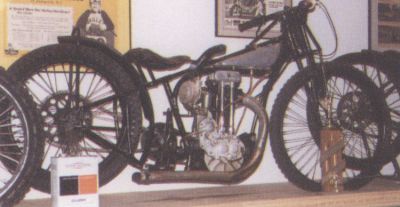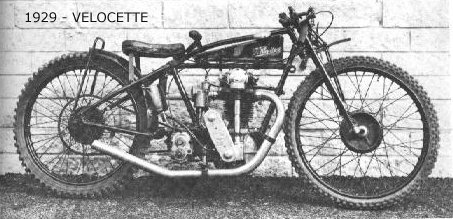


The Machine Evolution.
For a considerable period of time speedway machines have been standardised, but
it has not always been so; the early days saw a "Galaxy" of models that added a
tremendous attraction to the whole set-up.
The variety and the ingenuity of the conversions made to them had, perhaps, a great
deal to do with the rapid growth of the popularity of the sport. Speedway in the
early days was certainly a paradise for motorcycle enthusiasts, for they could see
almost every make of machine during a weeks spectating.
Most British Motorcycle manufacturers took their 350 and 500cc sports models, took
off the lights and mudguards and added some bracing struts, something of a craze
as the bracing served little purpose or value and were not used on the Douglas's
or on Roger Frogley's first Rudge machine. It's also worth noting that early speedway
machines were clutchless as races were started
with rolling starts, the start tape method not appearing until around 1932. In 1928, Frogley used a fairly standard Rudge
machine. In the middle of that season however, Stanley Glanfield
designed a new model especially for "Dirt Racing" and was marketed under
the name of the Glanfield Rudge Special that housed a Whitworth engine
in a duplex frame with strutted tubes and soon after that, Rudge and AJS
started building specialised models, the Rudge opting for an all nickel-
plated frame with triangular bracing.(See Above Pic)
Later on emerged the American Indian machine, the only one to appear in speedway
with the formidable Art Pechar as its rider and of course the famous Harley Davidson
"Peashooters". The 345cc Peashooters were distinguishable by their handlebars, the
ends of which were nearly vertical.Eric Spencer had begun racing and his machine was a more carefully tuned TT
Douglas which had real speed, so much so that when Vic Huxley borrowed it at Harringay,
a huge chunk came off the track record.
Soon after, the Rudge and AJS companies commenced building specialised models. The new AJS
had a short wheelbase and latest TT motor whilst the Rudges were all nickel plated affairs
with special sprint tank and a sports engine. Meanwhile at Harringay, Frank Arthur's new 90mph
Harley appeared (see right) that had fantastic acceleration and in the Silver Helmet event, no other
machine could get anywhere near it.
A Coventry Victor machine was advertised for £85 and housed a horizontal flat-twin motor and the Zenith was introduced.
The Zenith's frame practically standard, was strengthened by additional struts which in affect made
it a triplex frame, the side members offering excellent protection for the engine. Both 350 and 500cc
models were available both with three speeds, though single speed machines were available.
As the result of much practice work at the Greenford and White City tracks, the P & P Company now offered
three special speedway mounts: a 500cc model selling at 66 guineas; a two port 350cc for 62 guineas and
a 350cc single port at 58 guineas.
At the Motorcycle Show at Olympia in November 1928, no less than seventeen manufacturers exhibited their dirt track models
that would raise the cinder dust in 1929. The stands which displayed one or more models were Scoot, Zenith,
Cotton, Royal Enfield, BSA, Dunelt, New Imperial, Chater Lea, Calthorpe, Rex Acme, Triumph, Rudge Whitworth,
Douglas, New Henley, McEvoy, Coventry Victor and the James.
What a fascinating show that must have been. The popularity of the show was emphasised by the fact that 138,417
people paid for admission.
The new BSA looked extremely neat and business like. It had a special frame, giving a short wheelbase, and housing
a high-compression (8.5 to 1) twin-port 493cc engine. The oil system was a simple hand pump in the top of the petrol/oil
tank . Transmission was through an ordinary BSA clutch and gearbox, but there were no intermediate pinions or a kickstart.
Each model that left the factory was tested by Jack Parker on a new track that the company had constructed at its works.
The price of these various machines was interesting. The Rudge and BSA with specialised engines listed at £70 each which even then
was considered reasonable, while the Douglas came out at £85 with its TT engine.
With the showtime over, the 1929 Dirt Track season commenced and practice began at the White City Stadium as early as March.
It was immediately obvious that an enormous amount of machines would still be ridden.

